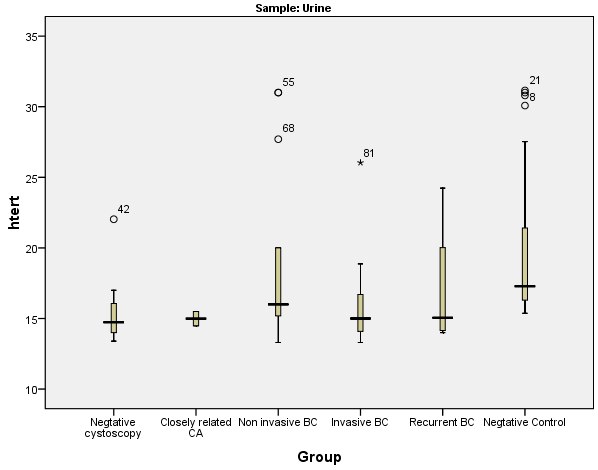Relationship between Human Telomerase Reverse Transcriptase Gene and Some microRNAs Expression Levels in Patients with Bladder Cancer
DOI:
https://doi.org/10.54133/ajms.v7i1.1229Keywords:
Bladder cancer, Gene expression levels, hTERT, miRNAsAbstract
Background: Bladder cancer (BC) is the fourth most prevalent cancer among the top ten malignancies, and human telomerase reverse transcriptase (hTERT) played a role in its pathogenesis. Objective: To investigate the link between hTERT expression levels and miRNA-29c, miRNA-125, miRNA-141, miRNA-145, and miRNA-205 expression levels in BC patients. Methods: A total of 149 tissue biopsies and/or urine samples were collected from patients with urinary tract complications, including BC patients, as well as patients who served as negative controls for BC (negative cystoscopy, prostate cancer patients), and healthy people. To measure the hTERT gene expression level, total RNA was extracted and reverse-transcribed to cDNA. Then, quantitative real-time PCR was performed using specific primer sets. Results: hTERT expression levels in BC patients were significantly higher; however, there was no statistically significant difference between the grade of non-muscle invasive BC or the stages of muscle invasion in urine or tissue biopsy samples. The expression of hTERT and miRNAs (miRNA-29c, miRNA-125, miRNA-141, miRNA-145, and miRNA-205) genes in urine and tissue biopsies was significantly correlated. BC patients had upregulated hTERT expression levels in tissue biopsies and urine samples but lower expression levels of miR-141 and miR-205 compared to negative cystoscopy patients. Conclusions: The combination of miRNA and hTERT expression levels may serve as a good prognostic marker for predicting BC in both urine and tissue.
Downloads
References
Kittler R, Shiang C, Hutchinson R, Kollipara RK, Kapur P, Franto F, et al. Grade progression in urothelial carcinoma can occur with high or low mutational homology: a first-step toward tumor-specific care in initial low-grade bladder cancer. Oncotarget. 2018;9(10):9415-9424. doi: 10.18632/oncotarget.24072. DOI: https://doi.org/10.18632/oncotarget.24072
Yahyazadeh R, Bashash D, Ghaffari P, Kord S, Safaroghli-Azar A, Ghaffari SH. Evaluation of hTERT, KRT7, and survivin in urine for noninvasive detection of bladder cancer using real-time PCR. BMC Urol. 2021;21(1):64. doi: 10.1186/s12894-021-00838-z. DOI: https://doi.org/10.1186/s12894-021-00838-z
Alnafakh RAA, Adishesh M, Button L, Saretzki G, Hapangama DK. Telomerase and telomeres in endometrial cancer. Front Oncol. 2019;9:344. doi: 10.3389/fonc.2019.00344. DOI: https://doi.org/10.3389/fonc.2019.00344
Colebatch AJ, Dobrovic A, Cooper WA. TERT gene: its function and dysregulation in cancer. J Clin Pathol. 2019;72(4):281-284. doi:10.1136/jclinpath-2018-205653. DOI: https://doi.org/10.1136/jclinpath-2018-205653
Dratwa M, Wysoczańska B, Łacina P, Kubik T, Bogunia-Kubik K. TERT-regulation and roles in cancer formation. Front Immunol. 2020;11:589929. doi: 10.3389/fimmu.2020.589929. DOI: https://doi.org/10.3389/fimmu.2020.589929
Trybek T, Kowalik A, Góźdź S, Kowalska A. Telomeres and telomerase in oncogenesis. Oncol Lett. 2020;20(2):1015-1027. doi: 10.3892/ol.2020.11659. DOI: https://doi.org/10.3892/ol.2020.11659
Di Nunno V, Aprile M, Bartolini S, Gatto L, Tosoni A, Ranieri L, et al. The biological and clinical role of the telomerase reverse transcriptase gene in glioblastoma: A potential therapeutic target? Cells. 2023;13(1):44. doi: 10.3390/cells13010044. DOI: https://doi.org/10.3390/cells13010044
Wen W, Mai SJ, Lin HX, Zhang MY, Huang JL, Hua X, et al. Identification of two microRNA signatures in whole blood as novel biomarkers for diagnosis of nasopharyngeal carcinoma. J Transl Med. 2019;17(1):186. doi: 10.1186/s12967-019-1923-2. DOI: https://doi.org/10.1186/s12967-019-1923-2
Smolarz B, Durczyński A, Romanowicz H, Szyłło K, Hogendorf P. miRNAs in cancer (Review of literature). Int J Mol Sci. 2022;23(5):2805. doi:10.3390/ijms23052805. DOI: https://doi.org/10.3390/ijms23052805
Menon A, Abd-Aziz N, Khalid K, Poh CL, Naidu R. miRNA: A promising therapeutic target in cancer. Int J Mol Sci. 2022;23(19):11502. doi: 10.3390/ijms231911502. DOI: https://doi.org/10.3390/ijms231911502
Compérat EM, Burger M, Gontero P, Mostafid AH, Palou J, Rouprêt M, et al. Grading of urothelial carcinoma and the new "World Health Organisation Classification of Tumours of the Urinary System and Male Genital Organs 2016". Eur Urol Focus. 2019;5(3):457-466. doi: 10.1016/j.euf.2018.01.003. DOI: https://doi.org/10.1016/j.euf.2018.01.003
Chen SM, Tao ZZ, Hua QQ, Liu D, Chi HM, Cai Q. Inhibition of human telomerase reverse transcriptase in hep-2 cells using short hairpin RNA expression vectors. Arch Otolaryngol Head Neck Surg. 2006;132(2):200-205. doi: 10.1001/archotol.132.2.200. DOI: https://doi.org/10.1001/archotol.132.2.200
Livak KJ, Schmittgen TD. Analysis of relative gene expression data using real-time quantitative PCR and the 2(-Delta Delta C(T)) method. Methods. 2001;25(4):402-408. doi: 10.1006/meth.2001.1262 DOI: https://doi.org/10.1006/meth.2001.1262
Serrano D, Bleau AM, Fernandez-Garcia I, Fernandez-Marcelo T, Iniesta P, Ortiz-de-Solorzano C, et al. Inhibition of telomerase activity preferentially targets aldehyde dehydrogenase-positive cancer stem-like cells in lung cancer. Mol Cancer. 2011;10:96. doi: 10.1186/1476-4598-10-96. DOI: https://doi.org/10.1186/1476-4598-10-96
Abbas SM, Dhahi MA, Muhammad SH. Evaluation of gene expression level of miRNA-29c, miRNA-125, miRNA-141, miRNA-145 and miRNA-205 as predisposing factors for transitional cell carcinoma-bladder cancer in Iraqi patients. Iraqi J Sci. 2023;64(8):3799-3811. doi: 10.24996/ijs.2023.64.8.7. DOI: https://doi.org/10.24996/ijs.2023.64.8.7
Batista R, Vinagre N, Meireles S, Vinagre J, Prazeres H, Leão R, et al. Biomarkers for bladder cancer diagnosis and surveillance: A comprehensive review. Diagnostics (Basel). 2020;10(1):39. doi: 10.3390/diagnostics10010039. DOI: https://doi.org/10.3390/diagnostics10010039
Xie XY, Yang X, Zhang JH, Liu ZJ. Analysis of hTERT expression in exfoliated cells from patients with bladder transitional cell carcinomas using SYBR green real-time fluorescence quantitative PCR. Ann Clin Biochem. 2007;44(Pt 6):523-528. doi: 10.1258/000456307782268093. DOI: https://doi.org/10.1258/000456307782268093
Mezzasoma L, Antognelli C, Del Buono C, Stracci F, Cottini E, Cochetti G, et al. Expression and biological-clinical significance of hTR, hTERT and CKS2 in washing fluids of patients with bladder cancer. BMC Urol. 2010;10:17. doi: 10.1186/1471-2490-10-17. DOI: https://doi.org/10.1186/1471-2490-10-17
Eckburg A, Dein J, Berei J, Schrank Z, Puri N. Oligonucleotides and microRNAs targeting telomerase subunits in cancer therapy. Cancers (Basel). 2020;12(9):2337. doi: 10.3390/cancers12092337 DOI: https://doi.org/10.3390/cancers12092337
Borkowska EM, Konecki T, Pietrusiński M, Borowiec M, Jabłonowski Z. MicroRNAs which can prognosticate aggressiveness of bladder cancer. Cancers (Basel). 2019;11(10):1551. doi: 10.3390/cancers11101551. DOI: https://doi.org/10.3390/cancers11101551
Yik MY, Azlan A, Rajasegaran Y, Rosli A, Yusoff NM, Moses EJ. Mechanism of human telomerase reverse transcriptase (hTERT) regulation and clinical impacts in leukemia. Genes (Basel). 2021;12(8):1188. doi: 10.3390/genes12081188. DOI: https://doi.org/10.3390/genes12081188
Abdelgawad A, Mosbah A, Eissa L. Expression of microRNA-155 and human telomerase reverse transcriptase in patients with bladder cancer. Egypt J Bas Appl Sci. 2020;7(1):315-322. doi: 10.1080/2314808X.2020.1816337. DOI: https://doi.org/10.1080/2314808X.2020.1816337

Downloads
Published
How to Cite
Issue
Section
License
Copyright (c) 2024 Al-Rafidain Journal of Medical Sciences ( ISSN 2789-3219 )

This work is licensed under a Creative Commons Attribution-NonCommercial-ShareAlike 4.0 International License.
Published by Al-Rafidain University College. This is an open access journal issued under the CC BY-NC-SA 4.0 license (https://creativecommons.org/licenses/by-nc-sa/4.0/).











